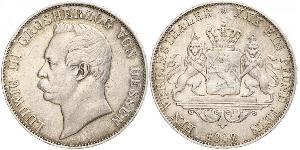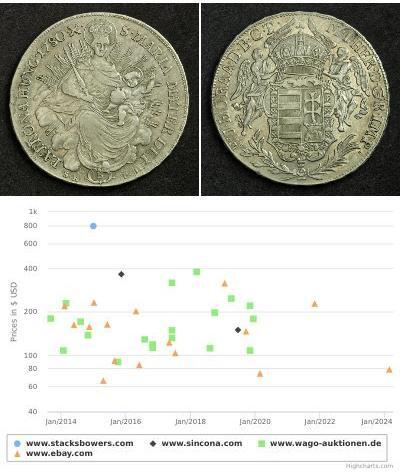2 Thaler (Vendue pour $160.0)
1843, Baden (Grand Duchy), Leopold I. Large Silver 2 Thaler (3½ Gulden) Coin. XF-
Mint Year: 1852 Reference: KM-220. Denomination: 2 Thaler (3½ Gulden) Condition: Numerous circulation-marks, scratches, a few hits and light deposits, otherwise XF! Material: Silver (.900) Weight: 37.02gm Diameter: 42mm
Obverse: Head of Leopold I of Baden right. Legend: LEOPOLD GROSHERZOG VON BADEN Reverse: Crown above coat-of-arms with a shield of Baden, supported by gryphons and adorned with triple cross-order chains. Legend: 3½ GULDEN VII EINE F. MARK 2 THALER . VEREINS (18-52) MÜNZE .
em>.
Leopold I, Grand Duke of Baden (Karlsruhe, 29 August 1790 â€" Karlsruhe, 24 April 1852) succeeded in 1830 as the fourth Grand Duke of Baden.
Although a younger child, Leopold was the first son of Margrave Karl Friederich of Baden by his second, morganatic wife Louise Karoline, Baroness Geyer of Geyersberg. Since Luise Karoline was not of equal birth with the Margrave, the marriage was deemed morganatic and the resulting children were incapable of inheriting their father's princely status or the sovereign rights of the Zähringen House of Baden. Luise Karoline and her children were given the titles of baron and baroness and later count or countess of Hochberg.
Baden gained territory during the Napoleonic Wars. As a result, Margrave Karl Friederich was elevated to the title of Prince-Elector of the Holy Roman Empire (Kurfurst). With the dissolution of the Holy Roman Empire in 1806, he took the title Grand Duke of Baden.
Since there were plenty of descendants from Charles Frederick's first marriage to Karoline Louise of Hesse-Darmstadt, no one expected the Hochberg children of his second wife to be anything except a family of counts with blood ties to the grand ducal family but no dynastic rights. With no prospects of advancement in Baden, Leopold of Hochberg followed a career as an officer in the French army.
Starting in 1817, events resulted in a dramatic change in the situation of the Hochberg children when it became apparent that the Baden male line descended from Karl Friederich's first wife would die out. One by one, the males of the House of Baden died without leaving male descendants. By 1817, there were only two males left, the reigning Grand Duke Charles I and his childless uncle Louis I. Both of Charles's sons died in infancy. The dynasty faced a serious succession problem.
A series of agreements provided that Baden would be inherited by the Wittelsbach kings of Bavaria at the extinction of the Zähringen male line in Baden. King Maximilian I Joseph of Bavaria was married to Grand Duke Charles's eldest sister, Katharina Karoline. The female most closely related to the last male often inherited in such circumstances (sometimes called Semi-Salic succession). As a result, Maximilian had a strong claim to Baden under the normal rules of inheritance and various agreements added weight to his claims. Following the Congress of Vienna, a treaty of 16 April 1816 between Bavaria and Austria secured the Wittelsbach rights to Baden.
To save his dynasty from extinction, Grand Duke Charles needed to find a way to preserve the Zähringen line. Granting succession rights to his half-uncles seemed the ideal solution. Accordingly, in 1817 Karl issued a new succession law under which the children of the Hochberg marriage became princes and princesses of Baden with full dynastic rights. Leopold of Hochberg became His Grand Ducal Highness, Prince Leopold of Baden and second-in-line to the throne after his remaining half-brother, Louis.
In 1818, Charles granted a liberal constitution to the people of Baden. This constitution ensured the succession rights of the offspring of Louise Karoline Geyer von Geyersberg. Finally, on 10 July 1819, a few months after Charles's death, the great powers (Great Britain, France, Austria, Russia, and Prussia) joined with Bavaria and Baden in the Treaty of Frankfurt which recognized the succession rights of the former Hochberg morganatic line.
After Grand Duke Charles died on 8 December 1818, his full-uncle (the son of Charles Frederick's first marriage) succeeded as Louis I. To further improve the status of his half-brother and heir, Ludwig arranged for the new Prince Leopold to marry his great-niece, Sophie, daughter of former King Gustav IV Adolf of Sweden by Grand Duke Charles's sister, Frederica. Since Sophie was a granddaughter of Leopold's oldest half-brother, Charles Louis, this marriage united the descendants of his father's (Grand Duke Charles Frederick's) two wives. Sophie's undoubted royal blood would help to offset the stigma of Leopold's morganatic birth.
When Grand Duke Louis died on 30 March 1830, he was the last male of the House of Baden not descended from the morganatic marriage of Charles Frederick and Louise Karoline Geyer of Geyersberg. The former morganatic child Leopold of Hochberg, recently raised to princely rank, now succeeded as the fourth Grand Duke of Baden.
Leopold was interested in the liberal ideas of his time, granted concessions to his subjects in 1848, and in the spring of 1849 declined to oppose the movement (see Revolutions of 1848 in the German states) which finally broke down all barriers and forced him to flee from the country on the night of 13 May. In August, he was reinstated by the troops of Prussia and the German Confederation. He acted with the greatest forbearance after regaining his power. During the last years of his reign, he admitted his son Frederick, who later succeeded him, to a share in the government.
Only 1$ shipping for each additional item purchased!

|
Posté par:
anonymous 2017-05-24 |
|
||
|
||
|
||
|
||
|
||
1 Groschen Allemagne Argent Auguste Ier d'Oldenbourg
Le groupe a 2 pièces / 2 prix
⇑

-600-300-j5YKX9ISkUoAAAFcDHKA5TkN.jpg)

-300-150-w4wKbzbivsIAAAFNLP9tvwzV.jpg)
 Deutsch
Deutsch Русский
Русский Українська
Українська English
English Italiano
Italiano Français
Français Español
Español 汉语
汉语
















